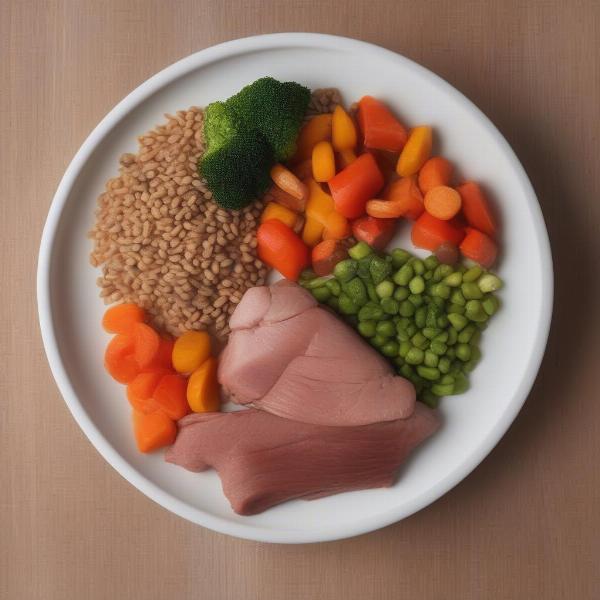Muscle meat is a cornerstone of a healthy diet for many dogs, offering a concentrated source of protein and essential nutrients. Understanding the benefits and how to safely incorporate muscle meat into your dog’s meals is key to maximizing their health and well-being. This guide delves into the advantages of feeding muscle meat to dogs, the different types available, and best practices for preparation and serving.
Why Choose Muscle Meat for Your Dog?
Muscle meat, as the name suggests, comes from the skeletal muscles of animals and is packed with the protein dogs need for strong muscles, healthy tissue repair, and overall growth. It’s a highly digestible protein source, meaning your dog can efficiently absorb and utilize its nutrients. Beyond protein, muscle meat provides essential amino acids, which are the building blocks of protein and crucial for various bodily functions. It’s also a good source of vitamins and minerals like iron and zinc, vital for maintaining a healthy immune system and supporting overall wellness. For dogs with allergies or sensitivities to common protein sources like chicken or beef, novel muscle meats like venison or rabbit can be excellent alternatives.
Types of Muscle Meat for Dogs
A variety of muscle meats can be incorporated into your dog’s diet. Common choices include beef, chicken, turkey, pork, lamb, and fish. Each type offers a unique nutritional profile, so rotating between them can provide a balanced intake of nutrients. Less common but equally beneficial options include venison, rabbit, duck, and kangaroo. These “novel” proteins are often a good choice for dogs with food allergies.
Safe Handling and Preparation of Muscle Meat
Raw feeding, which includes muscle meat, has gained popularity, but it’s crucial to handle raw meat safely to minimize the risk of bacterial contamination. Always purchase meat from reputable sources and store it properly. Thorough handwashing after handling raw meat is essential. If you choose to cook the muscle meat, ensure it reaches an internal temperature of 165°F (74°C) to eliminate harmful bacteria. Avoid adding seasonings or spices that could be toxic to dogs, such as onion and garlic.
How Much Muscle Meat Should My Dog Eat?
The amount of muscle meat your dog needs depends on factors like age, breed, activity level, and overall health. Consult your veterinarian or a certified canine nutritionist to determine the appropriate portion sizes for your individual dog. Overfeeding muscle meat can lead to nutritional imbalances, so it’s important to follow a balanced feeding plan. best food for australian cattle dog offers helpful guidelines on creating a balanced diet.
 Appropriate Muscle Meat Portion for a Dog
Appropriate Muscle Meat Portion for a Dog
Incorporating Muscle Meat into Your Dog’s Diet
Whether you’re feeding kibble, homemade meals, or a raw diet, muscle meat can be easily integrated. You can mix small pieces of cooked or raw muscle meat into your dog’s regular food. meatballs for dogs are a fun and convenient way to incorporate muscle meat. For raw feeders, blue ridge beef for dogs provides high-quality options. Don’t forget to consider adding other essential components like organ meats, bone, and vegetables for a complete and balanced raw diet. duck hearts for dogs can be a valuable addition to a raw diet.
Conclusion
Muscle meat offers significant nutritional benefits for dogs, providing a rich source of protein, essential amino acids, vitamins, and minerals. By understanding how to safely prepare and incorporate it into your dog’s diet, you can help them thrive. Remember to consult with your veterinarian for personalized advice on the best approach for your furry friend.
FAQs
- Is raw muscle meat safe for my dog? Raw feeding can be safe if done correctly, with careful sourcing, handling, and preparation. However, it carries risks, so consult your vet.
- Can puppies eat muscle meat? Yes, puppies can benefit from the protein in muscle meat. Ensure it’s appropriately sized and prepared for their age.
- What are the signs of a muscle meat allergy in dogs? Symptoms include itching, skin rashes, digestive upset, and ear infections. Consult your veterinarian if you suspect an allergy.
- How do I transition my dog to a diet that includes muscle meat? Introduce it gradually to avoid digestive upset, starting with small amounts and increasing the portion slowly.
- Can I feed my dog only muscle meat? A diet solely of muscle meat is not balanced. Dogs need a variety of nutrients, so consult a vet or canine nutritionist for a balanced feeding plan.
- What are some good alternatives to muscle meat if my dog is allergic? Novel proteins like venison, rabbit, or insect-based protein sources can be good alternatives.
- Where can I buy high-quality muscle meat for my dog? Reputable butchers, pet supply stores, and online retailers specializing in raw or fresh pet food are good sources.
ILM Dog is a leading online resource dedicated to providing dog owners worldwide with expert advice and information on all aspects of dog care, from breed selection and nutrition to training and health. We offer practical, reliable guidance to help you make informed decisions about your dog’s well-being. Whether you’re a new dog owner or a seasoned expert, ILM Dog has the resources you need to ensure your canine companion lives a long, healthy, and happy life. Contact us at [email protected] or +44 20-3965-8624 for personalized support and guidance.